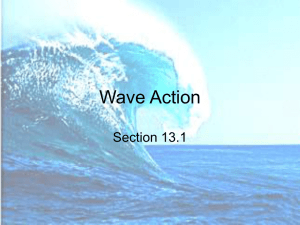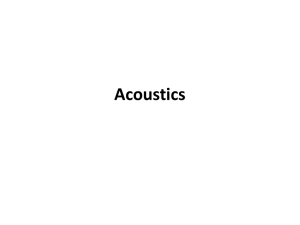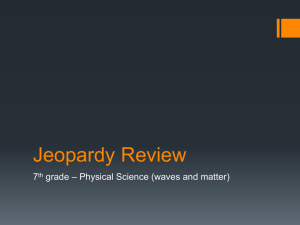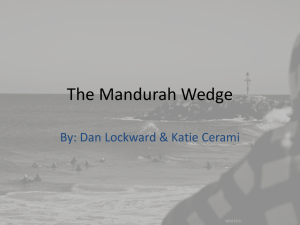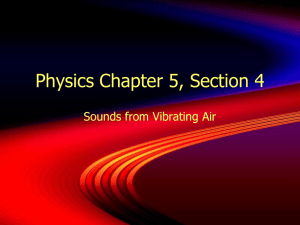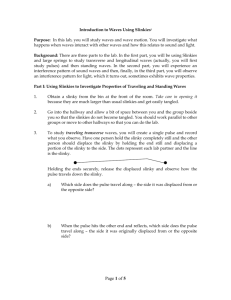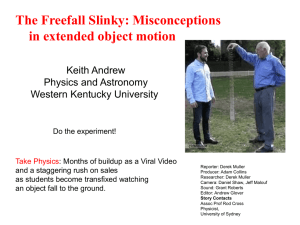Waves - Rathjen Science!
advertisement
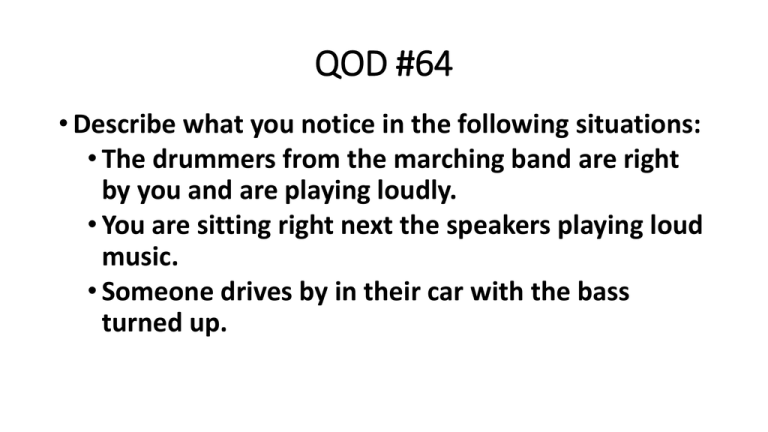
QOD #64 • Describe what you notice in the following situations: • The drummers from the marching band are right by you and are playing loudly. • You are sitting right next the speakers playing loud music. • Someone drives by in their car with the bass turned up. Waves Students can draw and describe the difference between longitudinal and transfer waves. Students can label the crest, trough, rarefaction, compression, wavelength, 2-3-14 Waves Waves – a disturbance that transfers energy from one place to another without transferring matter. 1. Transverse Waves – waves that move up and down -Electromagnetic waves (including light waves) are transverse waves. Crest Wavelength Trough • Wavelength – the distance from one point on a wave to the same point on the next wave • Crest – the highest point on a transverse wave • Trough – the lowest point on a transverse wave 2. Longitudinal Waves – the particles move straight out from the source, bumping each other. •Sound waves are longitudinal waves. Wavelength Rarefactions Compressions • Compressions – the region of a sound wave where the particles are closest together • Rarefactions – the region of a sound wave where the particles are farthest apart Sound/ Longitudinal ElectroMagnetic/ Transverse Yarn & Slinky Activity 1. Take the yarn and stretch it across the table between you and a partner. Move the yarn side to side on the table and observe how it moves. 2. Take the slinky between two people and one person sharply push one end of the slinky forward. Observe how the slinky moves. 3. Answer the questions in your notebook. Yarn & Slinky Questions 1. Which type of wave does the movement of the yarn represent? (Answer PQPA) 2. Draw the shape of the wave made from the yarn and label the crest, trough, and wavelength. 3. Which type of waves does the movement of the slinky represent? (Answer PQPA) 4. Draw the slinky coils and label a compression, rarefaction, and wavelength. QOD #65 • Draw and label where the compression, rarefaction, and wavelength are in this diagram. Name the type of wave. Sound Energy How sound travels Sound travels through longitudinal waves, also known as compression waves. They travel directly outward from the source of the vibration. Making waves • What is created after the object hits the water? • What happens when the wave in the water hits an object? • It reflects the wave • The reflected wave is an echo Mediums – substances that sound waves travel through. •Solids •Liquids •Gases In what type of medium does sound travel the fastest? Gas Liquid Solid Does the Medium make a difference? High and Low Pitched High Frequency Low Frequency Frequency – the number of wavelengths that pass by a point each second Unit for Frequency = Hertz (Hz) How do we measure frequency? Think about a fire truck • What happens as it passes by? • http://www.animations.physics.unsw.edu.au/jw/dopp ler.htm • Doppler effect- change in pitch when a sound source is moving in relation to an observer QOD #66 •Define the term medium and give three examples. How the ear hears • http://www.youtube.com/watch?v=ahCbGjasm_E • Decibels- the pressure that sound waves exert How old are your ears? • http://www.youtube.com/watch?v=VxcbppCX6Rk Decibels/Loudness Damage of Decibels Sound Stations 1. Tuning forks – (Describe what happened when you struck different tuning forks) 2. String cup telephones – (Did they work? What was the secret to making them work?) QOD #67 •How does sound travel? Be specific! Sound Energy Recap Sound is the result of vibrations in matter. Sound energy is transferred by (1) waves (2) spreading away from the source (3) through particle-to-particle interaction. Show Video Pitch – the perception of how high or low a sound seems • Higher frequency = higher pitch • Lower frequency = lower pitch • Loudness depends on the amplitude of a wave • Amplitude – the height of the wave Pitch vs. Loudness 2-6-13 Speed of Sound • Speed of sound (in air): 768 mph (343 m/s) Watch videos http://www.youtube.com/watch?v=6o0zmafxTmE&list=PLbjgX3AqxjQVQHo 3VIC7JpYnTELDWxXe3&index=5 http://www.today.com/video/today/49414119#49414119 Recap… 1. Sound is the result of _____. 1. Vibrations in matter 2. How is sound energy transferred? (3 parts) 1. 2. 3. By waves They spread away from the source Through particle to particle interaction 3. The matter or material that sound waves travel through is called? 1. A medium 4. What are some examples of a medium for sound? 1. air, water, metal 5. Why can you not hear sound in space? 1. Because there is no medium, or particles, for sound waves to travel through. Review… • What is the distance from one point on a wave to the same point on the next wave? • A wavelength • What is measured by the number of wavelengths that pass by a point per second? • Frequency • What is the unit for frequency? • Hertz (Hz) • What is the range of frequencies that humans can hear? • 20 Hz to 20,000 Hz Review… • Which has the highest frequency? •A •B •C • Fill in the blank… • The shorter the wavelength, the _______ the frequency. • The longer the wavelength, the _______ the frequency. Review… • The perception of how high or low a sound seems is the _______? • Pitch • Fill in the blanks… • The higher the frequency, the ______ the pitch. • The lower the frequency, the ______ the pitch. • Longitudinal vs. transverse wave? • Draw a wave and label the crest, trough, and wavelength.


